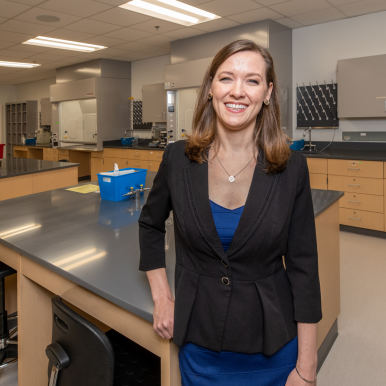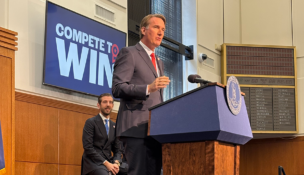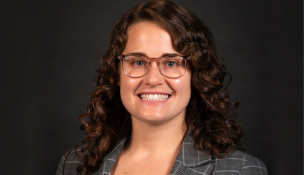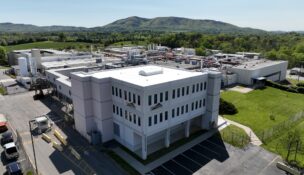Take a load off
State workforce program speeds company timelines
Take a load off
State workforce program speeds company timelines
One thing Brian Dail noticed as he spent a day and a half in February 2020 participating in step van manufacturer Morgan Olson‘s new hire training in Loudon, Tennessee, was the physical strain.
After the first hour, he told his colleagues, “‘Gosh, I’m not used to being on my feet. I’m ready to sit down.’”
But Dail wasn’t going through onboarding as a new hire. He’s managing director of customized training operations for the Virginia Economic Development Partnership’s Virginia Talent Accelerator Program, a discretionary incentive program that provides free customizable workforce recruiting and training services for eligible businesses locating or expanding in Virginia. Dail went through Morgan Olson’s onboarding training so that he and his team of five could begin to develop customized training for the 703 hires needed for the manufacturer’s Danville-area assembly plant. (Announced in late 2019 with an initial $57.8 million investment, the Morgan Olson factory is located in a former Ikea furniture plant just over the city line in Pittsylvania County’s Ringgold area.)
Dail wasn’t the first to notice the amount of standing time required of Morgan Olson’s assembly workers: “Consequently, that’s some of the feedback that they were getting,” he recalls.” People weren’t used to the physicality of it.” In response, Dail’s VEDP team developed a tailored training program that addressed the concern by progressively reducing classroom time and increasing lab time in order to condition trainees for the demanding work.
Morgan Olson opened the plant on time in June 2020, despite the then-raging COVID-19 pandemic.
“I attribute a lot of it to the state,” specifically VEDP, says Morgan Olson President and CEO Mike Ownbey. “Their training people came to our plant in Tennessee and saw how we manufactured trucks, and then they went back and set up training cells. … We closed on the plant and started producing trucks less than 90 days later.”
The talent accelerator completed its obligation, training the Morgan Olson plant’s 703rd employee in August 2021. The plant reached full production in July 2022 but is temporarily down to 500 people due to chassis supply chain issues, Ownbey says. Morgan Olson plans to build staffing back as the chassis shortages improve.
The Virginia Talent Accelerator Program helps the commonwealth compete for projects like the Morgan Olson facility and the jobs that come with them, by alleviating companies’ concerns about securing a trained workforce. From fiscal year 2020 through January 2023, the talent accelerator helped secure more than 10,000 jobs in Virginia, according to VEDP.
The program is a collaboration between VEDP and the Virginia Community College System. With company input, VCCS develops credential and industry certification programs to create a talent pipeline aimed at meeting future workforce needs after the VEDP program ends.
Doing the heavy lifting
“Virginia has long had an incentive that provides basically grant funding to offset the recruitment and training costs for [expanding or relocating] companies … but we did not have what some of our top [competitor states] provided, which is a full-service, customized recruitment and training solution,” says VEDP President and CEO Jason El Koubi. The talent accelerator has filled that gap for Virginia.
Since its launch in 2019, the talent accelerator has committed to assisting 29 projects, which are in various phases.
Global health care company GlaxoSmithKline, for example, has completed its expansion, hiring 150 scientists in Richmond as part of a $16.7 million build-out of its consumer research center announced in 2019. Shipping and logistics company CMA CGM Group hired about 400 employees, largely to expand its Hampton Roads operations, with the help of the talent accelerator. Lego Group, meanwhile, is in the early stages of the program for its $1 billion Chesterfield County facility, projected to create more than 1,760 jobs over the next 10 years. In August 2022, VEDP and VCCS staff visited Lego’s facilities in Mexico while conducting a needs analysis. They were set to return in February to film training and marketing videos.
VEDP helped Lego hire 15 salaried employees as of February. Lego plans to hire about 60 production employees by June with VEDP’s assistance, and about 500 employees by the end of the year. They will work in Lego’s temporary facility, packaging kits produced elsewhere, until the permanent facility opens in 2025 and production begins.
Clients have been pleased with the accelerator, which has earned accolades from industry publications and netted success stories to share with companies looking to locate new projects or expand existing assets in the commonwealth.
“We buy a lot of companies and do this all the time, and the state of Virginia is by far the best that I’ve dealt with … in terms of workforce development,” Ownbey says.
The recruiting and training materials and processes developed by VEDP’s talent accelerator team had a noticeable effect on Morgan Olson’s workforce. The Tennessee facility had an attrition rate above 50%, according to VEDP, but the Danville-area facility has a rate of about 10% to 15%.
“It was because we did that firsthand experience, and we put ourselves on the other side of the table, as I like to say, as a new hire,” Dail says.
Offering options
To be eligible for the talent accelerator, a company must have considered multiple states for its project. For manufacturing or distribution facilities, a project needs to create 25 jobs in its first year. For other projects, like information technology firms, corporate headquarters or call centers, a project must create 50 jobs within its first year. Wages for these jobs must be at or above a locality’s prevailing average wage, or 85% of the average wage if the community has an unemployment rate above the average statewide rate and/or a poverty rate greater than the statewide average rate.

As an alternative to the talent accelerator, companies can choose to participate in VEDP’s other job-based incentive program, the three-year Virginia Jobs Investment Program (VJIP). It provides cash grant reimbursements for associated human resources costs after a company has had new employees on the payroll for at least 90 days. About 225 to 275 companies participate in VJIP each year. Virginia allocates $4.67 million to VJIP annually, and VEDP can carry over any unused funds.
As for the talent accelerator, VEDP aims for it to commit to training for about 3,000 to 5,000 announced jobs each year. Last year, job creation announcements exceeded that goal. For fiscal 2023, the General Assembly allocated $9 million to the talent accelerator. VEDP can request additional funding for a large project through a General Assembly commission if needed.
Former VEDP President and CEO Stephen Moret spearheaded Virginia’s talent accelerator, replicating a successful custom workforce training program he and El Koubi created in 2008 for Louisiana Economic Development before both came to Virginia.
To head up Virginia’s talent accelerator, Moret hired Mike Grundmann, a VEDP senior vice president, from Georgia’s training program, QuickStart, which the Louisiana program was modeled after.
“Part of the advantage we have here in Virginia … is … because we had a group of people involved in designing it from the very beginning who all had deep familiarity with some of the other leading existing programs, namely those in Georgia and Louisiana,” El Koubi says.
In Business Facilities’ 18th Annual Rankings Report, released in 2022, Louisiana took first place in the state rankings for the 13th consecutive year. However, Virginia placed No. 2 for the second year, two spots above Georgia. Area Development magazine, another industry publication, ranked Virginia second for workforce development programs in 2022, with Georgia coming in first in 2021 and 2022. Virginia tied with Louisiana for second place in 2021.
These rankings matter, Grundmann explains: “It gets us in the mix on more projects. Site selection consultants read these publications, and when they see a state that has that kind of ranking … it helps us get considered for projects that we might have been overlooked for in the past.”
VEDP has recruited and trained more than 2,000 people through the talent accelerator since training sessions began in 2020, although the 4-year-old program is currently committed to training 10,000 hires. By comparison, Louisiana’s 15-year-old FastStart program has trained more than 6,100 people since 2019, according to Louisiana Economic Development spokesman Mark Lorando.
Getting to work
The talent accelerator team begins by conducting a needs analysis for clients. Once a company and VEDP agree on the scope of work, VEDP staff begin designing and developing recruiting and training materials as companies build their facilities and install equipment.
To aid clients with recruiting workers, VEDP creates materials such as advertisements, websites and promotional videos. For BlueStar Manufacturing LLC, which in October 2021 announced plans to build a $714 million medical glove factory in Wytheville, VEDP staff built the company’s website and included a place for potential job applicants to sign up for email updates about employment openings. Blue Star has said it plans to create 2,500 jobs by 2028.
VEDP’s talent acquisition team leverages multiple recruiting tactics to aid its clients, including social media, mailings, Google Ads and a cloud-based technology that can post to about 25 job boards at once, says Steve Youll, VEDP’s managing director of talent acquisition.
Kris Weidling, chief human resources officer at Civica Rx — a pharma company building its $124.5 million North American headquarters in Petersburg — praises VEDP’s talent acquisition team.
“Really,” he says, “we think of them as an extension of the HR group, since we don’t have a lot of people … [and] they’re saying, ‘What do you need to recruit and bring people here? And let’s help you with that until you get up to scale.’”
VEDP has assisted Civica with career fairs, helping create banners and pamphlets. The company had hired about 70 people as of January and expects to hire all 186 headquarters employees by 2025.

With a company’s approval, VEDP begins pre-hire trainings, which are two- to three-hour sessions comprised of hands-on activities for potential hires and time with instructors who detail the company’s culture, says Dail. His team provides assessment data from the hands-on activities to companies to aid in hiring decisions.
Lego and VEDP are currently planning and developing pre-employment assessments for production workers, though Lego staffers will train the first batch of production workers this summer at the company’s production facility in Monterrey, Mexico.
VEDP’s staffers “have a really good grasp of what we do, and they can do it so quickly and so succinctly that we will definitely have our training ready by the time we start to hire,” says Nancy Frank, plant manager for Tyson Foods’ $300 million Danville-area facility in Ringgold, which is expected to create nearly 400 jobs and reach full production by the end of the year.
After a company has made its hiring decisions, VEDP moves into post-hire training. For Morgan Olson, VEDP secured space at Danville Community College and structured trainings so that classes of about 12 to 16 people would break into groups and rotate between the classroom and the shop floor, where teams of two would practice riveting. The hands-on practice also taught new hires how to communicate over the noisy work around them.
Dail and his team guided about 45 job candidates through pre-hire trainings weekly through 2020; Morgan Olson hired about 30 of those people each week, he says.
Resources abound
New-hire trainings often involve VEDP-created illustrated job aids, simulations, 3D animations and videos demonstrating processes or equipment. Any proprietary materials that VEDP creates for a company through the talent accelerator become that company’s property. As companies near job creation benchmarks, VEDP trainers begin turning training materials over to the company, with guidance on future usage.
“After the first conference call I had with [VEDP’s training team], my face was beaming and I’m like, ‘This is the best call ever,’ because there were so many resources offered that just really met all of our needs,” Frank says.
VEDP’s talent accelerator team also offers assistance with organizational development, including leadership skills. These trainings, too, are customizable. The team can create programs ranging from half a day to 160 hours, says Laura Boone, VEDP’s managing director of organizational development services. Morgan Olson used leadership trainings of varying lengths for each level of management at its Danville-area plant. Boone’s team also consults with new companies, helping them create materials such as employee handbooks or performance management systems.
After VEDP trains the last new hire from a company’s initially announced hiring benchmark, VCCS helps sustain the company’s workforce by creating a talent pipeline.
The talent accelerator onboards a company’s initial staff, and community colleges then take “more of the long-term view of continuing to bring in qualified applicants later on,” says Dana Newcomer, associate vice president of sector strategies and programs for the Community College Workforce Alliance (CCWA), a joint workforce training division of Brightpoint and Reynolds community colleges.
Course customization
Part of an emerging pharmaceutical manufacturing hub in Petersburg, VEDP talent accelerator clients Civica and AMPAC Fine Chemicals are partners on a $354 million federal contract to create domestic sources of pharmaceutical drugs and ingredients at risk of shortages. In 2021, AMPAC announced it would create 156 jobs in a $25 million facility expansion.
In August 2022, CCWA launched a two-semester career studies certificate course at Brightpoint, which it developed in about nine months with the companies’ input. VEDP identified a technical education and training consultant and paid a portion of his fees to help CCWA.
“The talent accelerator helped get us started by introducing us to the company, introducing us to the company’s workforce needs, identifying resources that we needed to get started with that program of study and curriculum design, and then loaning us a consultant for a period of months to help us get started with writing that curriculum,” says CCWA Vice President Elizabeth Creamer.
Students are learning sanitation and formulation techniques, equipment maintenance, standard operating procedure, good documentation practices and lab safety, says Cornelia Kavungo-Johnson, Brightpoint’s pharmaceutical manufacturing program director and an associate professor. Brightpoint hired her to be the full-time pharmaceutical manufacturing professor in May 2022.
CCWA is also working on a roughly 135-hour pharma manufacturing technician certification that would fall under Virginia’s FastForward program, a short-term training program for high-demand industries offered through local community colleges. As of January, CCWA was close to submitting the program to FastForward for approval and expects to begin offering it to the general public in March.
To the south, Danville Community College offers industrial maintenance, machining and similar certifications from the National Center for Construction Education and Research, some of which Tyson Foods identified as training it wanted for its employees, says Danville Community College President Jerry Wallace. “We might offer a standard NCCER training, but we also try to make sure that we customize when an employer needs a specific one for their workforce,” he says.
Client satisfaction with the program has added to economic development officials’ arsenal, growing the list of reasons a company should pick Virginia to locate or expand facilities.
“The thing that allowed [Louisiana’s] FastStart and the [Virginia] Talent Accelerator Program to get to the top so quickly is that every single company that used the program was delighted,” Moret says. “Then we used those folks [and] leveraged their testimonials, basically, to help make the case for the program.”
Morgan Olson, the Virginia talent accelerator’s first client, certainly seems to be a satisfied customer.
“I couldn’t be happier with the training I received and the workforce there,” Ownbey says. “The state’s the best I’ve dealt with, and I’ve dealt with a lot.”
T
















